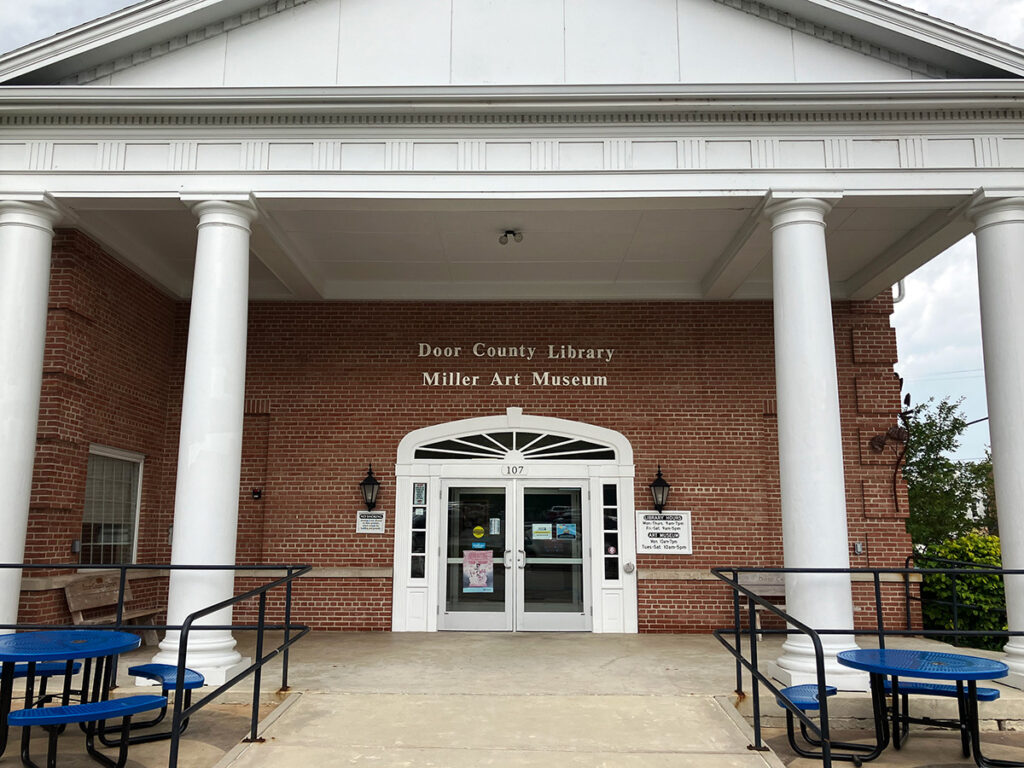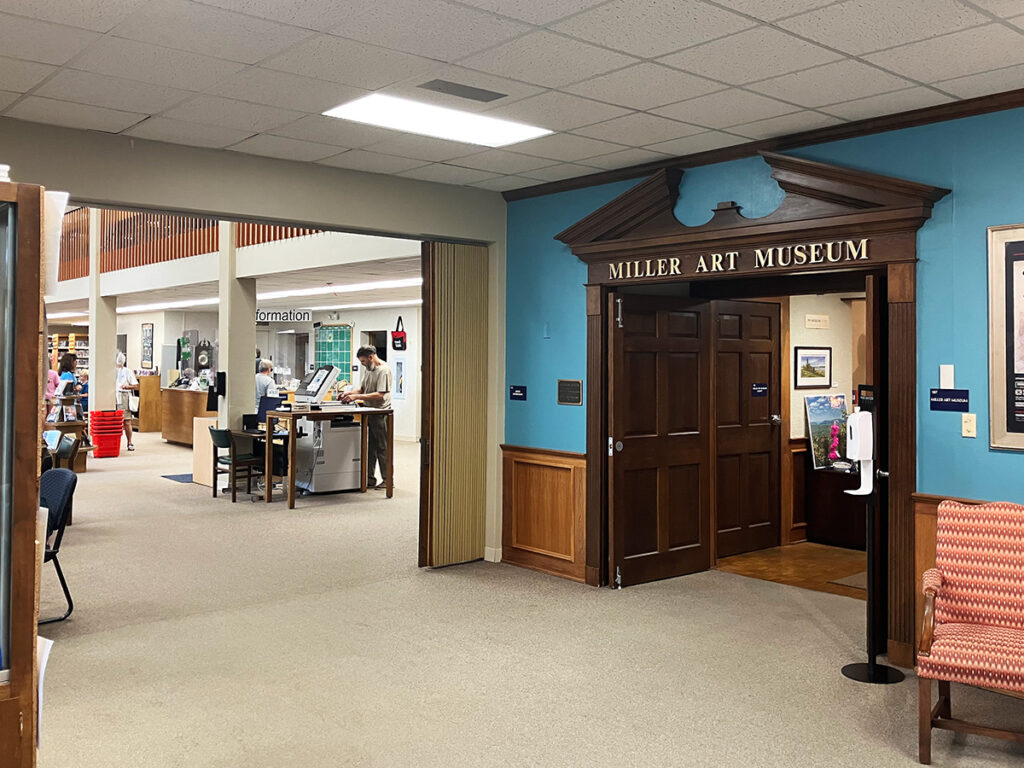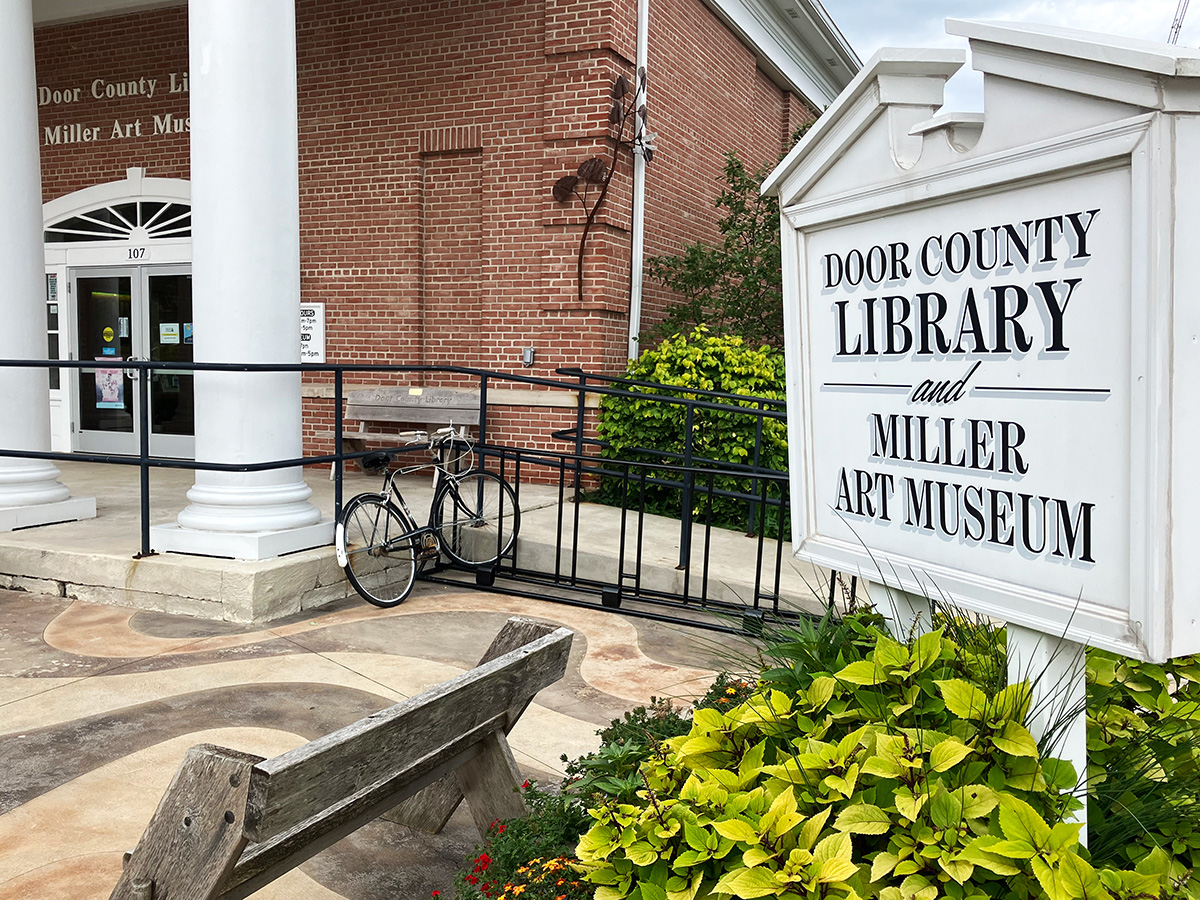After sharing a space for five decades, the Miller Art Museum is slated to move out of the building it shares with the Sturgeon Bay Library, according to an occupancy agreement proposed by the Door County Administrative and Finance Committee, and approved by the Door County Board of Supervisors on August 27.
The “Library-Miller Art Museum Building Occupancy Agreement” stipulates the Miller Art Museum will vacate the space it occupies in the building at 107 S. 4th Ave. by 2029. The agreement cites both the Miller’s plans for expansion, and Door County’s plans for the library as reasons for the occupancy termination. The current space arrangement will not accommodate either’s needs, according to the document.
The agreement also states that Door County and City of Sturgeon Bay—who jointly own the building—will each pay the Miller $500,000 in five annual installments beginning on January 1, 2025. This payment is based on “past contributions by both parties,” according to the agreement.
During a closed session at the county highway and facilities committee meeting on July 10 the tenancy and termination of use by the Miller was discussed. The first time the decision was made public was when a draft of the occupancy agreement appeared on the administrative and finance committee agenda on August 20 for vote.
Based on that vote, a revised agreement moved to the county board for approval on August 27.
The occupancy agreement was approved by 17 votes in favor, two absent, and two against. The dissenting votes were cast by Nissa Norton, District 12 Supervisor representing parts of the City of Sturgeon Bay, and Philip Rockwell, District 10 Supervisor also representing Sturgeon Bay. Norton serves on the library board as well.
The agreement will also go before the Sturgeon Bay city council at a future meeting, according to Pabich, as it is one of the three entities involved.
Statute and shock
During board discussion of the proposed occupancy agreement between the city, county and the Miller, Norton cited Wisconsin state statute 43.58. The statute says the library board has exclusive control of all assets acquired by the municipality for library purposes.
Based on the statute, Norton said, the occupancy agreement should have come before the library board to be approved before going to the finance and administrative board or county board.
“We should have had input,” she said. “Does every supervisor realize the library board is not for (in favor of) this? (The library board is) very, very against removing the Miller.”
The occupancy agreement came as a shock to the library board, according to Dominic Frandrup, the director for Door County libraries. He said he had heard rumors about it, but the first time he saw the agreement was on the administrative and finance agenda.
As far as the legal standing of the statute, Frandrup said, he concurs with Norton that the occupancy agreement should have been put in front of the library board before moving on to the administrative and finance committee. The interpretation of the statute by the county board might be different, he said, but the library board was totally left out of the decision.

Even if the library does not have oversight, he added, making the agreement public through the library board would have been better than letting them find out after the fact.
From the county’s perspective, the city and county jointly own the building and the library is one of two tenants, according to Ken Pabich, county administrator. One tenant does not have a say over the other tenant’s arrangement, he said.
District 16 Supervisor David Enigl agreed with Pabich and the county’s interpretation of the relationship. The building is property of the city and county with two entities in it, he said during board discussion. Enigl represents the towns of Egg Harbor and Jacksonport.
“I never viewed it as an art museum under the library umbrella.This is a way for us to move on to the next stage,” he said. “I don’t think there was an intent for the art museum to stay there forever. Ultimately this is a structure the county and city owns and we want to change it and the art museum is in agreement with it.”
Relationship history
The Miller is an independent, nonprofit 501(c)(3) organization. There has never been a formal lease agreement between the city, county and the Miller, according to Pabich, and the art museum foundation has contributed funding for two additions to the building, including installing an elevator.
The county administrative and finance committee negotiated the $1 million payout to the Miller, split between city and county, in the occupancy agreement. They came to that amount by looking at the life of the art museum and how things have evolved without any formal agreement, Pabich said.
“How can you unwind that to make it fair to all involved? The city and county provided the space, the Millers made contributions, invested into the building,” he said. “We want to recognize their investment and find a balance.”
Unwinding the relationship between the Miller and the library starts with a Memorandum of Understanding approved by the library board and submitted to the finance committee in 1995. The MOU is between the Door County library and the Miller Art Center (as it was called originally), and it includes a history of resolutions, letters, minutes and other documents between the two entities.
In the late 1960s, the Sturgeon Bay library was attempting to expand outside of its basement home at 354 Michigan St. in Sturgeon Bay, but could not secure enough funding. In September 1970, Gerhard and Ruth Miller transferred ownership of a building to the Sturgeon Bay library board. The library board sold the building and used the proceeds to fund an art gallery with two conditions attached, included in the MOU: the art gallery was to be incorporated into a new library building and had to be constructed within five years.
The Millers’ donation funded one third of the new library building and Miller Art Center, according to the MOU. The city and county each paid another one third for the construction.
The MOU also states: “the Miller Art Center has been considered an additional unit of service of the Door County Library system as are the bookmobile or the individual unit libraries.”

The library and Miller collaborated and resided side by side for decades. A Miller Art Museum report has been included in almost every library board meeting agenda on record. In 2018, both entities were involved in an informal space survey conducted by the Door County Library Foundation, a nonprofit organization dedicated to fundraising for the library.
The survey indicated both the library and Miller desired more space. At the library board’s July 19, 2019, meeting, both entities met and agreed to explore renovation and/or new construction for the Sturgeon Bay branch library and the Miller. A motion was made, seconded and approved that the library and the Miller move forward together with the expansion and continue their partnership.
Miller Art Museum Operations Board member Hermke Timm is quoted in the 2019 meeting minutes as saying, “The Door County library is the heart of the community and the Miller Art Museum is the soul of the community.”
Former Library Director Tina Kakuske concurred that when she was on the library board, the goal was to partner with the Miller to pursue expansion together, to the benefit of all.
Moving on
James Vander Heiden, a member of the Miller Art Museum board and retired vice president at HGA, an architecture and engineering firm with offices in Milwaukee and Madison, presented a building plan executed by HGA for the Miller to the City of Sturgeon Bay Plan Commission on July 19.
The plan outlines a brand new museum campus on the waterfront, in what the city’s master plan has designated an “arts district”.
It is just one of the options and plans the Miller is exploring, according to Elizabeth Meissner-Gigstead, executive director of the art museum. She said there was nothing more specific than a change in needs behind the museum’s decision to move on without the library.
It became more apparent to the museum in the last few years that their space needs would not be met in the current building, Meissner-Gigstead said, indicating the museum’s growing collection of art.
She also said the long term health of the nonprofit was a large part of the Miller board’s decision, and the museum wants to protect their autonomy and feasibility.
She thinks the library can move forward, and the art museum can move forward. “It (the museum) was a gift to Door County and we want to continue that gift,” she said.
Pabich also expressed optimism about the opportunities the split opens up for both entities. He said there is no animosity toward the Miller on the part of the county, nor is the occupancy agreement a way to push them out, but “the paths have divided.”
From a county perspective, the library building is a wonderful asset, he said, but it is a 50-year-old asset that needs to evolve to continue to provide services to residents and visitors.
“It’s a win-win,” Pabich said, “A vision for the future.”
Library director Frandrup is trying to remain optimistic as well, he said, but “I’m super sad things have gone this way.”
Door County was a leader in this kind of visionary arrangement, he said, referring to the partnership between library and art museum. Other libraries have emulated the model, adding art spaces in their own libraries, according to Frandrup.
“My hope is not severing our relationship but reimagining our relationship.”
Door County Library Director Dominic Frandrup on the future of the relationship between the library and Miller Art Museum.
Though things did not occur as he and the library board had expected, he said, the move will allow for both the library and art museum to expand and “literally think outside the box (current building) in how both our organizations can serve our community in new and different ways in the future.”
The museum is great to work with, he added,
“The staff is great. Their exhibits are phenomenal. My hope is not severing our relationship but reimagining our relationship.”
The next step for the Sturgeon Bay library will be to undergo a space needs assessment of the 50-year-old building, Frandrup said, and the library board welcomes public input as well.
“I encourage our community to consider and dream about what services and resources they want to see in a Sturgeon Bay library that will serve them, and their families, for the next 50 years.”
Additional board updates and action
Capital Improvements Plan
The county finance committee submitted a resolution regarding a 2025-2029 capital improvements plan for placement on the 2025 budget. The resolution passed with no opposition, 17 in favor and four absent.
Within the CIP are a number of requests from various departments for large future expenses the county can prepare and save for in advance. The county board will prioritize these expenses over the next five years at its annual budget retreat on Sept. 5, administrator Pabich said.
One of the items on the list of priorities is a whole body security scanner requested by the Door County Sheriff’s Office for use at the jail. The machine, which scans for contraband such as drugs, weapons and other prohibited items, is listed at $191,500 and is the only item the sheriff’s office is requesting as part of their 2025 capital improvements budget.
The machine would be located in the officer booking area where medical and mental health pre-screening takes place before an individual in custody is remanded to the jail, according to Door County Chief Deputy Sheriff Pat McCarty.
The need for such a machine has been a “growing trend” in law enforcement, Pabich said in his report to the board. With the growth in use of opioids, there is potential that contraband or opioids can be brought into the jail that are unable to be located by current booking procedures, he said.
According to a U.S. Department of Justice study published in 2021, state prison overdose deaths jumped 600 percent from 2001 to 2018. County jails saw a 200 percent increase of fatal overdoses in the same time frame.
These scanners are fairly new technology, McCarty said, and Door County is a little behind other places in trying to obtain one. He added the scanners are used by many jails and prisons across the country.
The total CIP costs projected for the 2025 budget are $20,728,270, according to a draft published by the county. Total project costs projected for all of 2025 through 2029 total 72,851,350.
Mental health funding
Supervisor Norton made the motion to approve a resolution to be forwarded to the governor’s office that will ask for state investment for mental health funding in Door County. The county’s Community Support Program and crisis intervention services are funded by the county tax levy currently. Norton serves on the Health and Human Services Department board.
“The county, state and country are way behind in putting funding into mental health,” she said.
State community aid funding has not kept pace over the years with increased costs for services, resulting in counties bearing a disproportionate share of Community Support Program and crisis service costs from county tax levy, according to the resolution.
Because counties are limited in their capacity to use tax levy revenue due to state limits, the resolution states, the lack of aid increases combined with strict property tax controls makes it difficult for counties to maintain necessary and often state-mandated services.
The board voted unanimously in favor of adopting a resolution to support state investment for mental health funding in Door County.
Speed limit change
County drivers will see a speed limit change in Gibraltar soon. The board approved an ordinance to create a 45 mph speed zone on County Highway A, starting approximately 0.2 miles south of its intersection with State Highway 42.
Supervisors approved the change after reviewing the request from and results of a speed study conducted by the Town of Gibraltar. The speed study was conducted by the county sheriff’s office, and results did not support the reduction, according to Pabich.
The county did not have to follow the recommendations of the study, Pabich said, and supervisors could consider other aspects of the area, including prevalence of driveways, vision angles and school bus pickups.
The speed change originated from citizen requests after an accident involving a car and a school bus occurred on the stretch of highway last December, according to Todd Thayse. Thayse is the District 2 supervisor representing the Town of Brussels and the Town and Village of Forestville.
The Town of Gibraltar supported the request to create a 45 mph speed zone, making the drop in speed from 55 mph to 35 mph in that area more gradual.
Supervisor Ken Fisher, who represents District 6 including the Town and City of Sturgeon Bay, spoke against the ordinance. In his time serving on the board, these kind of requests come up frequently, he said, and if the study does not support lowering the speed limit, the request should be denied.
“It’s feel good legislation,” Fisher said, “and what you’ll end up with is a county that has nothing but a 35 mph or 45 mph speed zone throughout it.”
The ordinance passed with 15 in favor, four absent, and two against. The dissenting votes were cast by Supervisors Fisher and Enigl.
Broadband update
Jessica Hatch, community broadband coordinator, updated the board on the county’s broadband infrastructure project. Some municipalities in Door County have been waiting for federal funding that will start being dispersed this fall, according to Hatch.
The federal Bipartisan Infrastructure Law allocated $42 billion to the Broadband Equity, Access and Deployment Program for broadband infrastructure nationally. Roughly $1 billion was awarded to Wisconsin and will be handled by the Wisconsin Broadband Office.
In order to receive funding, municipalities and internet service providers will need to go through the granting process. Part of that process requires the county to show support for broadband deployment via resolutions, Hatch said.
She also said there may need to be multiple resolutions for multiple bids and applications from different municipal and provider partnerships that exist within Door County. Hatch anticipates bringing resolutions to the county board starting in October to support the application process.

